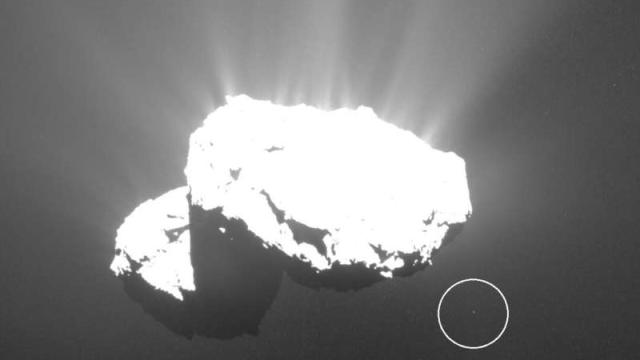An astrophotographer has spotted what looks to be a moon orbiting the comet 67P/Churyumov-Gerasimenko, the target of the European Space Agency’s Rosetta Mission.
The Rosetta mission launched in 2004, and arrived at 67P in 2014. Aside from producing lots of interesting data as well as thrills, it also sent many images of the comet back to Earth. These photographs continue to yield interesting findings.
Comets are icy solar system rocks that typically have oblong orbits and, when they get close to the Sun, heat up and emit gas and dust to create an atmosphere-like “coma” and sometimes a tail. 67P is one such example, a two-lobed object measuring up to 4 kilometres across on its longer lobe and 3 kilometres across on its shorter lobe. Its orbit takes it close to the paths of Earth and Jupiter. The Rosetta mission was the first to land a human-made object on a comet (though the landing was rocky). The mission also spotted 67p’s molecular oxygen, the kind that exists on Earth, which could date back to the early solar system.
Rosetta watched the comet spew gas and dust as it neared the Sun, creating the coma, beginning in the summer of 2015. This image shows a 4 metre chunk of the comet that seemed to be ejected during the outgassing event on October 21, 2015.
Astrophotographer Jacint Roger found the speck while mining the Rosetta image archives to create one of his gifs. Scientists reviewed the images and tracked the object as it appeared to orbit Rosetta until October 23. The object is the largest such chunk found around the comet yet, according to an ESA release.
ESA researcher Julia Marín-Yaseli de la Parra has dubbed objects like these “Churymoons,” according to the release.
ESA’s researchers are interested in the size and shape of these pieces of debris, and whether they change as the comet carries out its orbit. They hope to figure out whether the dust’s properties are changed by processes happening inside of the comet, or if the dust has been the same since the comet first formed, according to one research abstract.
Many space missions, from the Mars rovers to Rosetta, have sent countless images back to Earth that are free for you to access. You, too, can create gifs or artwork from this visual data. Maybe you’ll even discover something interesting.
